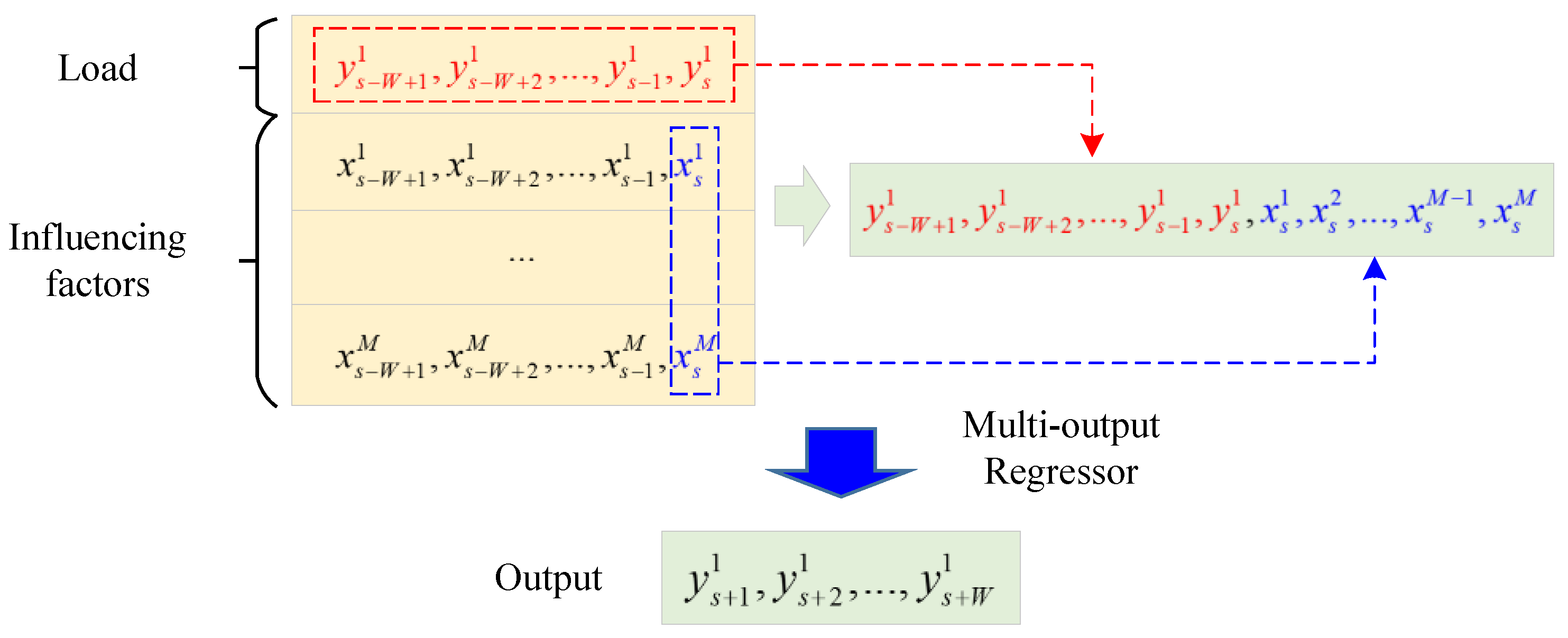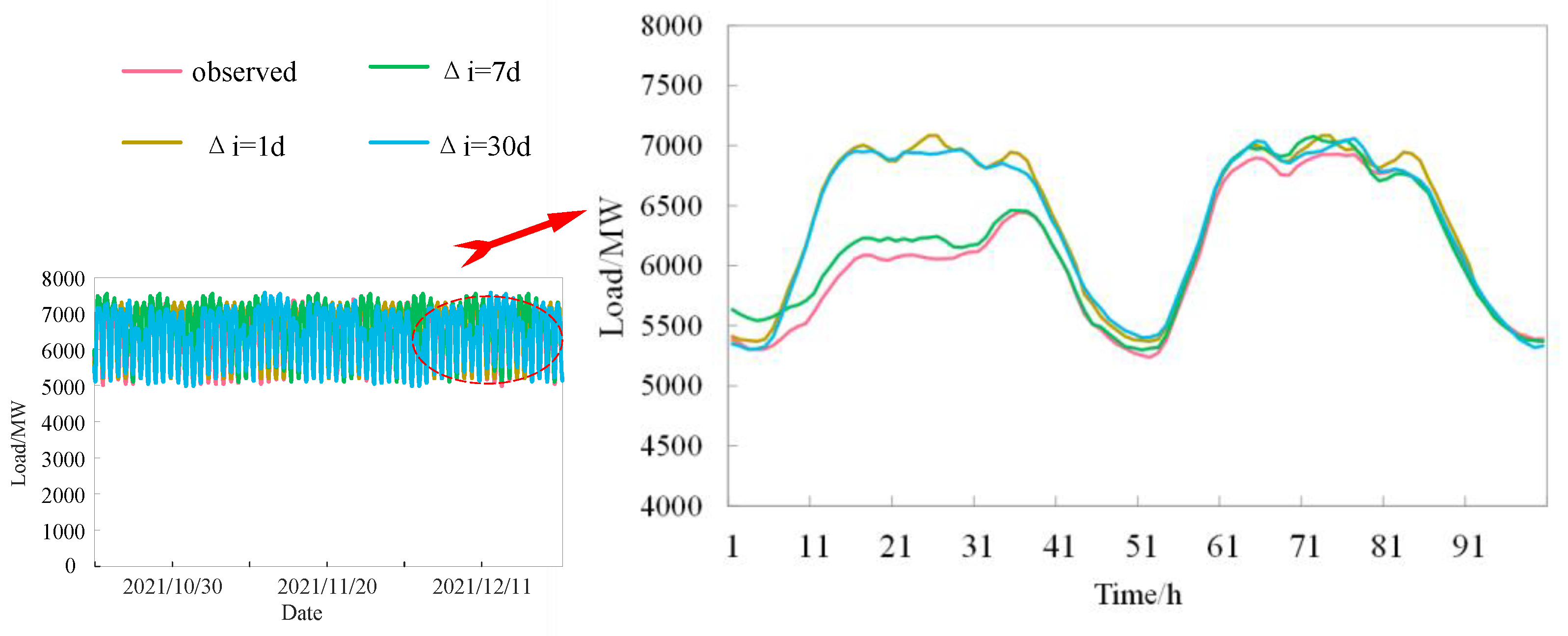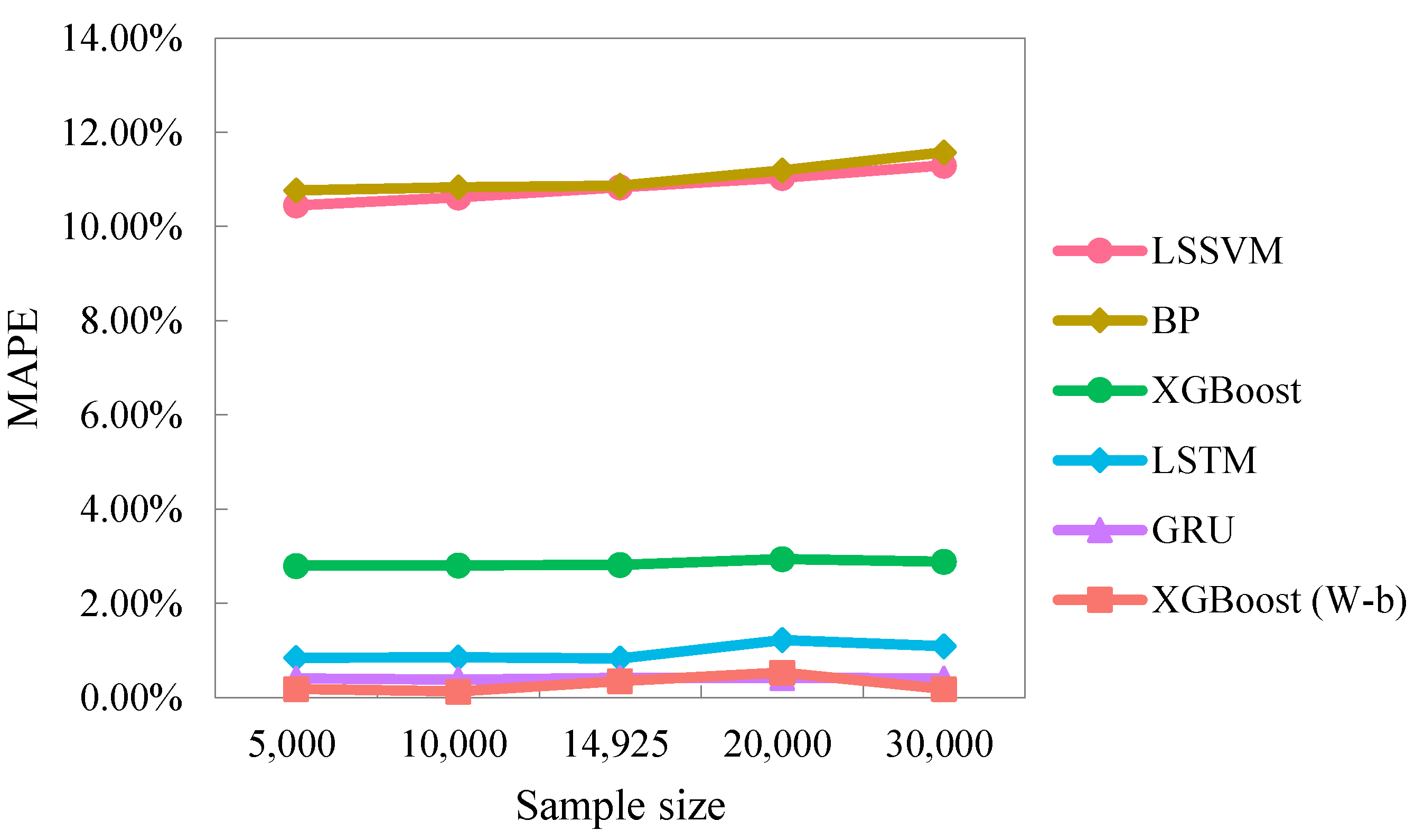Research on Ultra-Short-Term Load Forecasting Based on Real-Time Electricity Price and Window-Based XGBoost Model
Abstract
1. Introduction
2. Methodology
2.1. Traditional XGBoost Model
2.2. Window-Based XGBoost Model
3. Model Construction and Data Preprocessing for Ultra-Short-Term Load Forecasting
3.1. Construction of Ultra-Short-Term Load Forecasting Model Considering Real-Time Electricity Price
3.2. Data Description and Normalization
3.3. Prediction Accuracy Evaluation Index Selection
4. Case Study
4.1. Parameter Setting
4.2. Model Prediction Accuracy Based on Persistence Method (Baseline Analysis)
4.3. Comparison of Model Prediction Accuracy without Considering Real-Time Electricity Prices
4.4. Comparison of Model Prediction Accuracy Considering Real-Time Electricity Prices
4.5. Sensitivity Analysis
5. Conclusions
- (1)
- The introduction of the real-time electricity price has significantly improved the prediction accuracy of the model. The prediction errors of the XGBoost(W-b) model proposed in this paper and the other five comparison models decreased to varying degrees. Even without considering the real-time electricity price, the prediction effect of several models was not even as good as the persistence method. Therefore, the real-time electricity price should be taken into account in the electricity load forecast under the spot market environment;
- (2)
- Through the windowing transformation of the traditional XGBoost model, the prediction accuracyof this model was significantly improved. In the two scenarios of “without considering the real-time electricity price” and “considering the real-time electricity price”, its performance was no less than that of deep learning algorithms such as LSTM and GRU (commonly used in recent years), and the complexity of the model and the calculation time were also significantly reduced. Therefore, when solving the problem of power load forecasting, the complexity of the model should not be pursued blindly, and a targeted model suitable for the actual problem should be selected. Better performance may be obtained through the careful configuration of the traditional model;
- (3)
- In addition to the sample set given in this paper, when the sample size is further reduced (1/3 or 2/3 times) or expanded (4/3 or 2 times), the XGBoost(W-b) model proposed in this paper still has a higher prediction accuracy, which reflects the wide applicability of the prediction model proposed in this paper.
Author Contributions
Funding
Data Availability Statement
Acknowledgments
Conflicts of Interest
References
- Zhu, J.; Dong, H.; Zheng, W.; Li, S.; Huang, Y.; Xi, L. Review and prospect of data-driven techniques for load forecasting in integrated energy systems. Appl. Energy 2022, 321, 119269. [Google Scholar] [CrossRef]
- He, Y.; Xiao, J.; An, X.; Cao, C.; Xiao, J. Short-term power load probability density forecasting based on GLRQ-Stacking ensemble learning method. Int. J. Electr. Power Energy Syst. 2022, 142, 108243. [Google Scholar] [CrossRef]
- Wang, F.; Chen, P.; Zhen, Z.; Yin, R.; Cao, C.; Zhang, Y.; Duić, N. Dynamic spatio-temporal correlation and hierarchical directed graph structure based ultra-short-term wind farm cluster power forecasting method. Appl. Energy 2022, 323, 119579. [Google Scholar] [CrossRef]
- Wu, F.; Cattani, C.; Song, W.; Zio, E. Fractional ARIMA with an improved cuckoo search optimization for the efficient Short-term power load forecasting. Alex. Eng. J. 2020, 59, 3111–3118. [Google Scholar] [CrossRef]
- Yang, A.; Li, W.; Yang, X. Short-term electricity load forecasting based on feature selection and Least Squares Support Vector Machines. Knowledge-Based Syst. 2018, 163, 159–173. [Google Scholar] [CrossRef]
- Fan, G.-F.; Zhang, L.-Z.; Yu, M.; Hong, W.-C.; Dong, S.-Q. Applications of random forest in multivariable response surface for short-term load forecasting. Int. J. Electr. Power Energy Syst. 2022, 139, 108073. [Google Scholar] [CrossRef]
- Muzaffar, S.; Afshar, A. Short-Term Load Forecasts Using LSTM Networks. Energy Procedia 2019, 158, 2922–2927. [Google Scholar] [CrossRef]
- Li, D.; Sun, G.; Miao, S.; Gu, Y.; Zhang, Y.; He, S. A short-term electric load forecast method based on improved sequence-to-sequence GRU with adaptive temporal dependence. Int. J. Electr. Power Energy Syst. 2021, 137, 107627. [Google Scholar] [CrossRef]
- Shah, V.; Shroff, G. Forecasting Market Prices using DL with Data Augmentation and Meta-learning: ARIMA still wins! arXiv 2021, arXiv:2110.10233. [Google Scholar] [CrossRef]
- Elsayed, S.; Thyssens, D.; Rashed, A.; Jomaa, H.S.; Schmidt-Thieme, L. Do We Really Need Deep Learning Models for Time Series Forecasting? arXiv 2021, arXiv:2101.02118. [Google Scholar] [CrossRef]
- Tang, X.; Chen, H.; Xiang, W.; Yang, J.; Zou, M. Short-Term Load Forecasting Using Channel and Temporal Attention Based Temporal Convolutional Network. Electr. Power Syst. Res. 2022, 205, 107761. [Google Scholar] [CrossRef]
- Zhu, K.; Geng, J.; Wang, K. A hybrid prediction model based on pattern sequence-based matching method and extreme gradient boosting for holiday load forecasting. Electr. Power Syst. Res. 2020, 190, 106841. [Google Scholar] [CrossRef]
- Zhang, Z.; Lin, S.; Ye, Y.; Xu, Z.; Zhao, Y.; Zhao, H.; Sun, J. A Hybrid MCDM Model for Evaluating the Market-Oriented Business Regulatory Risk of Power Grid Enterprises Based on the Bayesian Best-Worst Method and MARCOS Approach. Energies 2022, 15, 2978. [Google Scholar] [CrossRef]
- Guo, X.; Zhao, Q.; Zheng, D.; Ning, Y.; Gao, Y. A short-term load forecasting model of multi-scale CNN-LSTM hybrid neural network considering the real-time electricity price. Energy Rep. 2020, 6, 1046–1053. [Google Scholar] [CrossRef]
- Wu, W.; Liao, W.; Miao, J.; Du, G. Using Gated Recurrent Unit Network to Forecast Short-Term Load Considering Impact of Electricity Price. Energy Procedia 2019, 158, 3369–3374. [Google Scholar] [CrossRef]
- Yan, Z.; Chen, H.; Dong, X.; Zhou, K.; Xu, Z. Research on prediction of multi-class theft crimes by an optimized decomposition and fusion method based on XGBoost. Expert Syst. Appl. 2022, 207, 117943. [Google Scholar] [CrossRef]
- Zhang, S.; Shi, Z.; Wang, G.; Yan, R.; Zhang, Z. Application of the extreme gradient boosting method to quantitatively analyze the mechanism of radon anomalous change in Banglazhang hot spring before the Lijiang Mw 7.0 earthquake. J. Hydrol. 2022, 612, 128249. [Google Scholar] [CrossRef]
- Brahim, B.; Majeed, F.; Ewusi, A.; Ahenkorah, I. Residual geochemical gold grade prediction using extreme gradient boosting. Environ. Challenges 2021, 6, 100421. [Google Scholar] [CrossRef]
- Ye, Q.; Wang, Y.; Li, X.; Guo, J.; Huang, Y.; Yang, B. A power load prediction method of associated industry chain production resumption based on multi-task LSTM. Energy Rep. 2022, 8, 239–249. [Google Scholar] [CrossRef]
- Hou, H.; Liu, C.; Wang, Q.; Wu, X.; Tang, J.; Shi, Y.; Xie, C. Review of load forecasting based on artificial intelligence methodologies, models, and challenges. Electr. Power Syst. Res. 2022, 210, 108067. [Google Scholar] [CrossRef]
- Kychkin, A.V.; Chasparis, G.C. Feature and model selection for day-ahead electricity-load forecasting in residential buildings. Energy Build. 2021, 249, 111200. [Google Scholar] [CrossRef]
- Zhao, Z.; Zhang, Y.; Yang, Y.; Yuan, S. Load forecasting via Grey Model-Least Squares Support Vector Machine model and spatial-temporal distribution of electric consumption intensity. Energy 2022, 255, 124468. [Google Scholar] [CrossRef]
- Wang, Y.; Niu, D.; Ji, L. Short-term power load forecasting based on IVL-BP neural network technology. Syst. Eng. Procedia 2012, 4, 168–174. [Google Scholar] [CrossRef]
- Li, Q.; Zhang, X.; Ma, T.; Liu, D.; Wang, H.; Hu, W. A Multi-step ahead photovoltaic power forecasting model based on TimeGAN, Soft DTW-based K-medoids clustering, and a CNN-GRU hybrid neural network. Energy Rep. 2022, 8, 10346–10362. [Google Scholar] [CrossRef]
- de Oliveira, J.F.L.; Silva, E.G.; Neto, P.S.G.D.M. A Hybrid System Based on Dynamic Selection for Time Series Forecasting. IEEE Trans. Neural Netw. Learn. Syst. 2021, 33, 3251–3263. [Google Scholar] [CrossRef]






| Indicator | Observation | Average | Min | Max | Std. |
|---|---|---|---|---|---|
| Load (MW) | 14,925 | 6160.19 | 4616.93 | 7314.83 | 600.21 |
| Electricity Price ($) | 14,925 | 154.24 | 30.36 | 3811.16 | 264.65 |
| Temperature (°C) | 14,925 | 27.74 | 23.30 | 31.70 | 3.50 |
| Humidity (%) | 14,925 | 84.18 | 82.8 | 86.9 | 1.30 |
| Parameter | Value | Description |
|---|---|---|
| 48 | Window size | |
| 0.025 | Initial learning rate | |
| 0 | Minimum value of the loss reduction required to specify leaf nodes for branching | |
| 2 | Maximum tree depth | |
| 300 | Number of decision trees | |
| 1 | Weight of leaf nodes | |
| 0.9 | Sub-sample size | |
| 0.9 | Random sampling ratio of features | |
| 0.8 | Ratio of the number of negative categories to the number of positive categories | |
| 27 | Random number seed |
| Model | Parameter | Value |
|---|---|---|
| LSSVM [22] | [0.01, 5000] | |
| [0.01, 100] | ||
| BP [23] | 10 | |
| LSTM | 300 | |
| 32 | ||
| GRU [24] | 300 | |
| 32 |
| MAE | MAPE | RMSE | |
|---|---|---|---|
| 318.39 | 3.31% | 318.39 | |
| 219.66 | 2.84% | 219.66 | |
| 424.74 | 5.08% | 424.74 |
| MAE | MAPE | RMSE | Computation Time | |
|---|---|---|---|---|
| LSSVM | 697.24 | 11.29% | 839.58 | 25.70 |
| BP | 729.92 | 11.82% | 872.77 | 7.63 |
| XGBoost | 464.92 | 7.62% | 549.18 | 40.36 |
| LSTM | 194.45 | 3.16% | 255.52 | 271.56 |
| GRU | 186.60 | 2.97% | 232.47 | 148.10 |
| XGBoost (W-b) | 64.18 | 1.02% | 96.11 | 12.53 |
| MAE | MAPE | RMSE | Computation Time | |
|---|---|---|---|---|
| LSSVM | 660.98 | 10.84% | 869.52 | 34.10 |
| BP | 702.11 | 10.87% | 854.37 | 15.14 |
| XGBoost | 178.05 | 2.82% | 200.03 | 47.28 |
| LSTM | 49.67 | 0.83% | 72.93 | 336.00 |
| GRU | 25.69 | 0.41% | 32.95 | 174.44 |
| XGBoost (W-b) | 22.02 | 0.35% | 34.23 | 11.48 |
Publisher’s Note: MDPI stays neutral with regard to jurisdictional claims in published maps and institutional affiliations. |
© 2022 by the authors. Licensee MDPI, Basel, Switzerland. This article is an open access article distributed under the terms and conditions of the Creative Commons Attribution (CC BY) license (https://creativecommons.org/licenses/by/4.0/).
Share and Cite
Zhao, X.; Li, Q.; Xue, W.; Zhao, Y.; Zhao, H.; Guo, S. Research on Ultra-Short-Term Load Forecasting Based on Real-Time Electricity Price and Window-Based XGBoost Model. Energies 2022, 15, 7367. https://doi.org/10.3390/en15197367
Zhao X, Li Q, Xue W, Zhao Y, Zhao H, Guo S. Research on Ultra-Short-Term Load Forecasting Based on Real-Time Electricity Price and Window-Based XGBoost Model. Energies. 2022; 15(19):7367. https://doi.org/10.3390/en15197367
Chicago/Turabian StyleZhao, Xin, Qiushuang Li, Wanlei Xue, Yihang Zhao, Huiru Zhao, and Sen Guo. 2022. "Research on Ultra-Short-Term Load Forecasting Based on Real-Time Electricity Price and Window-Based XGBoost Model" Energies 15, no. 19: 7367. https://doi.org/10.3390/en15197367
APA StyleZhao, X., Li, Q., Xue, W., Zhao, Y., Zhao, H., & Guo, S. (2022). Research on Ultra-Short-Term Load Forecasting Based on Real-Time Electricity Price and Window-Based XGBoost Model. Energies, 15(19), 7367. https://doi.org/10.3390/en15197367





